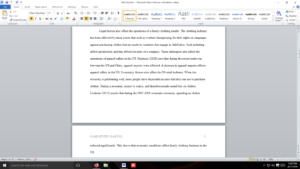Advertising and merchandising strategy
Provide a 4-5 Page summary evaluating the case study about GAP Inc. by answering the following questions in Part 1.
Gap, Inc. (Gap) became a household name in the 1990s through its clever advertising and merchandising strategy that made it largely responsible for making the jeans-and-t-shirt style ubiquitous during that decade. In this CLA, you will evaluate the pros and cons of Gap’s strategy, do a SWOT analysis, identify the strategic issues that Gap management needs to address, and propose action recommendations.
To prepare you for this Assignment, read the Gap Case on page 297. Then, review the following:
- A 1:38-minute 2015 video concerning “Why Is Gap Closing 175 Stores in North America,” that can be accessed at https://www.youtube.com/watch?
v=TdARiQIrFgE.
- A 2:01-minute 2015 video titled “Gap Inc. to Open Store in India” that can be accessed at
(Copy and paste this URL.)
You must justify your thoughts by supporting your arguments by providing the peer-reviewed sources (at least 8 sources).
Part 1 – (4-5 Pages):
Gap has employed you as a consultant to assess the company’s overall situation, identify the strategic issues that management needs to address, and recommend a set of actions to improve the company’s future prospects. Please prepare a minimum of four (4) APA formatted pages analytical/critical report to Gap management that includes the following:
- What are the strategically relevant components of the U.S. Retail, Family Clothing Stores industry macroenvironment?
- What is competition like in the family fashion industry? Which of the five competitive forces is strongest? Which is the weakest? What competitive forces seem to have the greatest effect on industry attractiveness and the potential profitability of new entrants?
- What does your strategic group map of the family clothing retail industry look like? Is Gap Inc. well positioned? Why or why or why not?
- What do you see as the key success factors in the market for family clothing?
- What key factors may determine the success of Gap Inc.?
- What recommendations would you make to Gap Inc. to improve its competitiveness in the market while mitigating any current and future risks?
Part 2 – (1-2 Page):
- In correct APA format, write the Reference of the article used for this Assignment.
- Clearly state what the article is about and its purpose.
- Describe how the article helped in this assignment.
- Repeat for a total of eight (8) peer-reviewed source.
he Case study from the text book
Answer preview
Competition in the family fashion industry is great. Competitive rivalry is strongest among Porter’s five forces. The competitors for Gap, Inc. are Inditex Group, Abercrombie & Fitch, and other e-commerce companies like Amazon. Varlard & Gamble (2017) says that in 2015, Amazon accounted for about 60% of the retail sales in the clothing industry. Over the last few years, Gap Inc has had to close stores in various parts of the world due to increasing competition in the fashion industry. Since 2000, company sales have been declining due to an increase in online sales. A shift in consumer buying habits has led to a decrease in customer visits to lower-end malls, malls that Gap Inc has a wider presence. The weakest force is supplier power. Many apparel companies create the same products. Companies can change their suppliers when they are dissatisfied with the quality or prices offered. Presently, suppliers have little control over apparel sellers, and hence they have low power. The forces that influence the attractiveness of the industry are buyer power and the threat of new entrants.
[2049 Words]
Advertising and merchandising strategy


